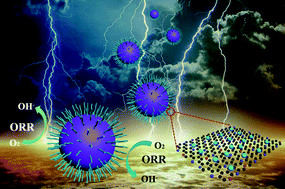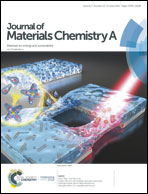Metallic cobalt nanoparticles embedded in sulfur and nitrogen co-doped rambutan-like nanocarbons for the oxygen reduction reaction under both acidic and alkaline conditions†
Abstract
Designing the porosity of functionalized hollow carbon-based materials that possess an abundance of active sites can shorten the diffusion paths of oxygen to facilitate the oxygen reduction reaction (ORR). Herein, we demonstrate a novel strategy to embed metallic cobalt in S and N co-doped carbon nanotubes (CNTs) that are uniformly grown onto hollow-mesoporous carbon spheres (HMCS) (denoted as Co@SNHC). The HMCS are used as an appropriate substrate to disperse CNTs around the outer surface when subjected to an in situ polymerization process followed by subsequent pyrolysis. Developing suitable contact between the HMCS and CNTs results in the formation of well-structured Co@SNHC electrocatalysts that exhibit good ORR performance with a half-wave potential (E1/2) of 0.831 V (vs. the reversible hydrogen electrode) in a 0.1 M KOH medium and a E1/2 of 0.682 V in a 0.1 M HClO4 medium. Most importantly, the Co@SNHC electrocatalysts exhibit remarkable stability and improved methanol tolerance with no observed changes to the cyclic voltammograms in both alkaline and acidic media. Therefore, the in situ growth of CNTs onto HMCS combines the active material and the electrically conductive carbon additive with stable electrical contact. Additionally, Co@SNHC as a cathode electrocatalyst in Zn–air cells possesses good power density, specific capacity and long cycle life, demonstrating great potential in practical applications for rechargeable energy devices.



 Please wait while we load your content...
Please wait while we load your content...